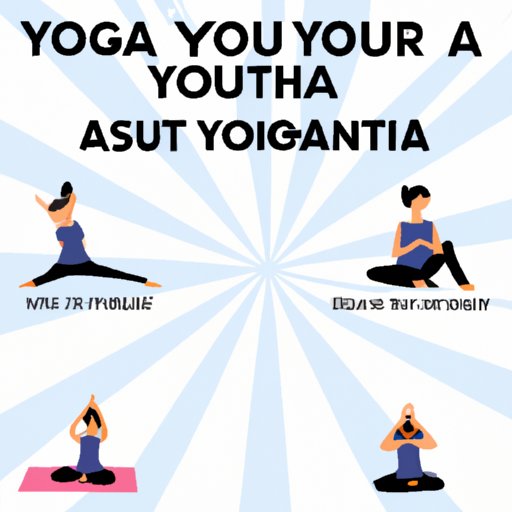Introduction
Yoga is an ancient practice that promotes balance in the body through developing both strength and flexibility. It is believed to have originated in India over 5,000 years ago, and has grown in popularity in recent decades due to its many benefits. Yoga is not just an exercise, but also a way of life and an approach to health and wellbeing. In this article, you will learn about the different types of yoga, the benefits of each type and how to incorporate yoga into your daily life.

Different Types of Yoga and Benefits
There are many different types of yoga with varying levels of intensity. Some are more suitable for beginners while others are better suited for experienced yogis. Here is a brief overview of five popular types of yoga and the benefits they offer.
Hatha Yoga
Hatha yoga is one of the most popular forms of yoga and is suitable for all levels. It focuses on slow, deliberate movements which help build strength and flexibility. The poses are held for longer periods of time, giving practitioners time to focus on alignment and breath. Hatha yoga can help improve posture, reduce stress, and increase energy levels.
Vinyasa Yoga
Vinyasa yoga is a dynamic form of yoga that focuses on linking breath to movement. This type of yoga involves flowing from one pose to the next in a continuous sequence. It is physically demanding and requires strength and flexibility. Vinyasa yoga can help build endurance, improve coordination, and increase cardiovascular fitness.
Restorative Yoga
Restorative yoga is a gentle form of yoga that uses props to support the body in each pose. Props such as bolsters, blankets and blocks are used to foster relaxation and provide support. This type of yoga is great for calming the mind and relieving stress. Restorative yoga can also help improve circulation, reduce fatigue, and boost immunity.
Bikram Yoga
Bikram yoga, also known as “hot yoga”, is a form of yoga practiced in a heated room. The heat helps to loosen muscles and facilitate deeper stretching. Bikram yoga is physically demanding and can be challenging for beginners. However, it can help improve flexibility, detoxify the body, and strengthen the immune system.
Benefits of Each Type
Each type of yoga offers its own unique benefits. Whether you are looking for a physical workout or a way to relax and de-stress, there is a type of yoga that can help. Practicing yoga regularly can help improve strength, flexibility, balance, and overall wellbeing.
Basic Beginner’s Routine for Practicing at Home
If you are new to yoga, it can be intimidating to attend a class. Fortunately, there are many resources available online to help you get started. Here is a basic beginner’s routine for practicing yoga at home.
Equipment Needed
To practice yoga at home, you will need a yoga mat, a towel, and some comfortable clothing. You may also want to invest in some yoga blocks, straps and bolsters to help you with the poses.
Step-by-Step Guide for Poses
Start by finding a quiet space where you won’t be disturbed. Begin by warming up your body with some simple stretches and then move into the poses. Focus on your breath and make sure to take breaks when needed. Here is a simple sequence of poses to get you started:
- Mountain Pose (Tadasana)
- Downward-Facing Dog (Adho Mukha Svanasana)
- Chair Pose (Utkatasana)
- Cobra Pose (Bhujangasana)
- Child’s Pose (Balasana)
- Corpse Pose (Savasana)
Tips for Form and Alignment
When practicing yoga, it is important to pay attention to your form and alignment. Make sure to keep your spine straight and your neck relaxed. Listen to your body and don’t push yourself too hard. If you experience any pain, stop and take a break.
Health Benefits of Regularly Practicing Yoga
In addition to improving strength and flexibility, regular yoga practice can also lead to a variety of health benefits. Here are some of the benefits of regularly practicing yoga:
Mental Health Benefits
Yoga can help reduce stress and anxiety and promote feelings of calm and wellbeing. It can also help improve concentration and focus, and can even improve sleep quality.
Physical Health Benefits
Regular yoga practice can improve posture, reduce inflammation and joint pain, and strengthen the muscles and bones. It can also help improve balance and coordination, and can even reduce blood pressure and cholesterol levels.

Tips for Incorporating Yoga into Your Daily Life
Once you are familiar with the basics of yoga, you can start incorporating it into your daily life. Here are some tips for making yoga part of your routine:
Scheduling Tips
It can be difficult to find time for yoga if you have a busy schedule. Try to set aside some time each day for yoga practice and make it a priority. Even if it’s just 10 minutes, it can make a big difference.
Modifications for Different Abilities
Yoga is for everyone, regardless of age or ability. If you have any physical limitations, there are modifications you can make to accommodate your needs. Talk to your doctor before starting a yoga routine to make sure it is safe for you.
Interview Experienced Yogis
If you want to learn more about yoga, consider interviewing experienced yogis. Ask them questions about their practice and what advice they have for beginners. Here are some questions you can ask:
- How long have you been practicing yoga?
- What type of yoga do you practice?
- What benefits have you noticed since starting yoga?
- Do you have any tips for someone just starting out?
Conclusion
Yoga is an ancient practice that offers many benefits for both physical and mental health. There are many different types of yoga, each with its own set of benefits. With some basic equipment and a few helpful tips, you can get started with yoga at home. Regularly practicing yoga can help improve strength, flexibility, balance, and overall wellbeing.


